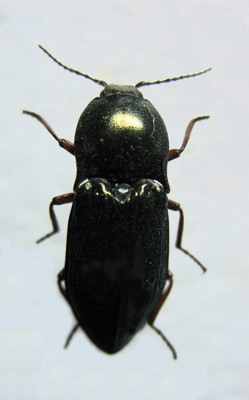Pests
Selatosomus aeneus L. . Brilliant Click Beetle
Systematic position.
Class Insecta, order Coleoptera, family Elateridae, subfamily Lepturoidinae, tribe Corymbitini, genus Selatosomus.Biological group.
Polyphagous pests.Morphology and biology.
Beetle is 12-15 mm long and 3 mm wide; it is dark green, shining bronze from above and black from below. Body of the beetle is flattened, glabrous dorsally. Pronotum is longer than wide. Legs are black or red. Eggs are white, nearly globe-shaped, 0.7 mm in diameter. Larva is bright yellow with metallic shine; it is 25 mm long and 3.3 mm wide. The end of last segment of larval body has 2 short projections with sharp-pointed tips being turned toward median line. Pupa is white and 16 mm long. The larvae in all the species of Elateridae are hard, nearly cylindrical and shining. They are called "wireworms" because they look like a wire fragment. S. aeneus has 3-5-year generation development. Beetles fly in May and June. They reproduce the end of May and June after additional feeding by leaf tissues on various grasses and trees. Females lay eggs on radical parts of plants or into soil fissures and forest litter. The female total productivity is 300-660 eggs. The eggs and pupae develop in soil, the larvae develop in soil, forest litter, rotten stubs, and in mushrooms. The larvae develop 2-4 years, depending on the climatic zone. During this period, they molt 8-12 times and winter in soil only. The adult larvae pupate in August. Young imagoes emerge in August or September and stay wintering in soil on a depth of 10-25 cm.Distribution.
S. aeneus is a widespread Eastern-Palearctic boreal species. Its area spreads all over the forest, steppe-forest, and mountain-forest zones of Eurasia from Atlantic to Pacific Ocean, including the Caucasus, Northern Kazakhstan and Northern Mongolia. The species is most numerous and harmful in the forest zone of Europe and European part of Russia, especially in districts of predominance of light mineral podzolic soils.Ecology.
S. aeneus is omnivorous, mainly phytophagous species. Imagoes are light-requiring, living openly; they are active at day time. Their pairing occurs on soil surface. In the forest zone, they select oviposition places mainly in fields with rare herbage on light soils, and in the grasslands, forest meadows, and light pine forests. But in more southern parts of the area, the beetles select mainly floodplain lands. The European populations of S. aeneus are considerably better adapted to life on cultivated soils in agroecosystems than its Asiatic populations. In Siberia, this beetle is a typical forest-grassland species, and its larvae are usually present on cultivated fields in the first years after plowing of virgin lands or on fallow fields. Eggs develop 26-33 days and pupae develop 20-23 days under the soil temperature 18-23°C. The thermal limits for feeding and development of larvae are 10 to 35°C. The larvae actively move in soil or in forest litter, seeking food or places with optimal thermal (18-21°C) and humidity conditions. Natural enemies of all elaterid beetles are ground-beetles of the genera Carabus, Calosoma, Harpalus, Amara (Coleoptera, Carabidae), more than 200 species of birds, and also moles, toads, and lizards. They eat many beetles and larvae on fields after spring and autumn plowings.Economic significance.
The larvae (wireworms) are only harmful in S. aeneus and other phytophagous beetles of the family Elateridae. They eat seeds, seedlings, and underground parts of various agricultural crops and weeds. S. aeneus is the serious crop pest only in Europe including the Non-Chernozem regions of the European part of Russia. In these territories, its larvae are the most numerous among all wireworm species. They are more harmful for the grain cereals (maize especially), sunflower, potato, vegetables, and for young fruit trees. In Siberia, the harmfulness of S. aeneus is rarely observed. Their harmfulness results in causing shoot thinning, depression of damaged plants, and deterioration of commercial quality of potato tubers, beet and carrot. The economical threshold of wireworm numbers in major crops (maize, potato, sugar beet) is 3 to 15 larvae per 1 sq. m. The real density of S. aeneus larvae in the Non-Chernozem districts of the European part of Russia is often many times higher than this level. Preventive and protective measures are the extermination of weeds, especially the couch-grass; deep subsurface tillage of fallow fields; cultivation and interrow treatment of soil on tilled crop plantations in spring and in early summer; early post-harvest autumn plowing of soil; extermination of crop plant residues; application of organic fertilizers in high doses; application of soil insecticides in spring before sowing if the wireworm population density is higher than economical threshold for the crop.Reference citations:
Anon. 2005. Economical Threshold Levels of main pests of agricultural crops. Plant Protection and Quarantine. 10: 36-38; 11: 40-43. (In Russian)Bobinskaya S.G., Grigorjeva T.G., Persin S.A. 1965. The wireworms and control measures against them. Leningrad: Kolos. 223 pp. (In Russian)
Chenkin A.F., Grivanov K.P., eds. 1974. Reference Book for plant protection. Moscow: Rosselkhozizdat. 400 pp. (In Russian)
Cherepanov A.I. 1965. Wireworms of Western Siberia. Мoscow: Nauka, 190 pp. (In Russian)
Dolin V.G. 1964. Elaterid beetle larvae (wireworms) of the European part of the USSR. Kiev: Urozhai. 206 pp. (In Russian)
Ermolenko V.M. 1971. Atlas of insect pests of field crops. Kiev: Urozhai. 176 pp. (In Ukrainian)
Gurieva E.L. 1972. Review of palaearctic click-beetles of genus Agriotes Esch. (Coleoptera, Elateridae). / Rus. Rev. Entomol. 51 (4): 859-877. (In Russian)
Kryzhanovsky O.L., ed. 1974. Beetles. Insects and mites . the pests of agricultural crops. Vol. II. Leningrad: Nauka. 336 pp. (In Russian)
Pavlov I.F. 1987. Protection of field crops from pests. Moscow: Rosselkhozizdat. 256 pp. (In Russian)
Shchegolev V.N., ed. 1955. Glossary-reference Book for Entomologist. Moscow & Leningrad: State Publ. Agricult. Liter., 451 pp. (in Russian).


